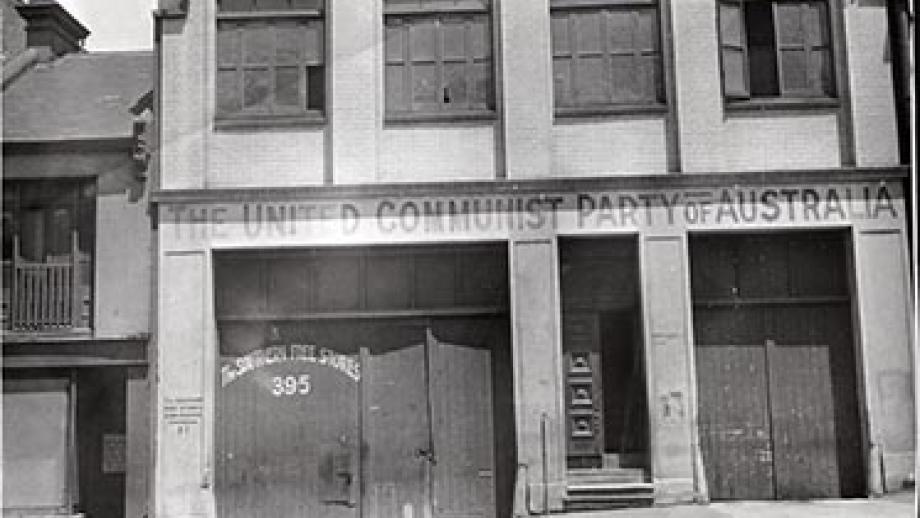Early Years
“On 30 October 1920 twenty-six men and women gathered at the Australian Socialist Party Hall in Sydney and formed the Communist Party of Australia” (A Davidson 1969).
Predating the formation of the Communist Party of Australia (CPA) in 1920, Australia had a growing Labor Movement and an increasing presence of organised socialists. Generally socialists were organised in three main areas: small socialist parties such as the Victorian Socialist Party (VSP) and the Industrial Workers of the World (IWW), trade unions, and a small number of Labor Party (ALP) members. However, the number of organised socialists in Australia during the early 1900s averaged no more than around 2,000 (A Davidson 1969). Socialists were generally quite conflicted regarding their relationship with the ALP, with some maintaining ALP membership and believing that a socialist agenda could be realised through the Party, and others who believed that maintaining an ALP membership was an abandonment of their socialist principles.
The First World War and the Great Strike of 1917 were huge catalysts for change in the Australian political landscape. The Labor Movement became deeply divided, particularly over the issue of conscription, with division between moderates and militants. Some moderate trade unions, such as the Australian Workers’ Union (AWU), left the Labor Council and established a moderate faction with support from some politicians, moderate unions and conservative Labor groups. In contrast, more militant ALP members gave their support to the IWW, which was fiercely opposed to conscription. In 1916 the IWW was banned under the Unlawful Associations Act; a move that incensed some ALP members and union leaders. The 1919 Labor Party Conference saw a clash between the AWU faction and the more militant members of the Party in the industrial faction, which included trade unionist and NSW Labor Council member Jock Garden.
Garden was already a member of the Socialist Party of Australia and the Industrial Socialist Labor Party, when he and William Earsman sought to establish the CPA in October 1920. They were spurred on by the divisions within the Labor Movement as well as the 1917 Bolshevik Revolution in Russia led by Vladimir Lenin’s Bolshevik Party, and the working class struggles which had culminated in the 1917 General Strike.
The formation of the Party was “one of the decisive revolutionary acts of the Australian working class” (L Sharkey 1944). It was a challenge to capitalist democratic governments and political parties and formed with the central goal of fighting for the “economic and social liberation of the Australian working class” (Australian Communist Party nd).
Many members of the CPA were drawn to the Party due to their frustration and disillusionment with ALP, although many remained members of the both the ALP and CPA, at least until the ALP adopted policies banning communists from being members of their party in 1924. At the time of its formation, the Party had around 750 to 1000 members concentrated around Sydney and Newcastle, with many members also a part of the trade union movement. Branches were also established in Queensland, South Australia, Western Australia and Victoria. The Victorian Party was led by Guido Baracchi and Percy Laidler, who faced opposition from the established VSP which had been formed in 1906 and had a peak membership of around 1,500 members.
In the early years of the Party, many of its policies were strongly influenced by the policies of other communist parties around the world, particularly the Communist Party of the Soviet Union (CPSU), but also with an agenda that considered the forces at work in Australia. There was a significant shift following the death of Lenin in 1924 and the subsequent rise of Josef Stalin to the leadership of the Soviet Party, a position he held until 1953.
From its very beginnings, but particularly following the rise of Stalin, the Party in Australia was conflicted, “torn between fighting for socialism and defending working-class interests and following Stalin's directives and defending the interests of the bureaucracy in the Soviet Union” (J Percy 1995). There was also conflict between the newly formed CPA and the pre-existing socialist parties, and despite best attempts and agreement on many issues, there was a failure to unite the different socialist groups and the CPA was often in conflict with the ASP.
References
Davidson, A 1969, The Communist Party of Australia: A Short History, Hoover Institution Press, Stanford, California
Macintyre, S 1998, The Reds, Allen & Unwin, St Leonards, Sydney
Percy, J 1995, Australia: Towards a History of the Communist Party of Australia, LINKS International Journal of Social Renewal, accessed <http://links.org.au/node/1117>
Gollan, R 1975, Revolutionaries and Reformists: Communism and the Australian Labour Movement 1920-1955, Australian National University Press, Canberra
Sharkey, L.L. 1944, An Outline History of the Australian Communist Party, A Marx School Publication, Australian Communist Party Newsletter Printery, Forest Lodge, Sydney
Armstrong, M 2020, 100 Years Since the Founding of Australia's Communist Party, Red Flag, accessed <https://redflag.org.au/index.php/node/7428>
Symon, P 2011, When the Party was Strong and Active, Australian Communist Review, issue 54, accessed <https://www.cpa.org.au/amr/54/amr54-02-when-the-party-was-strong-and-active.html>











